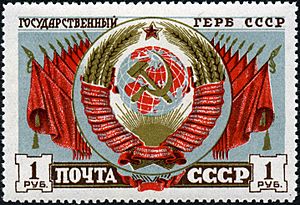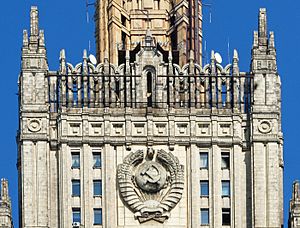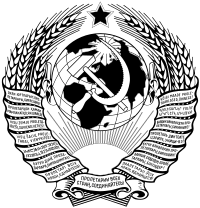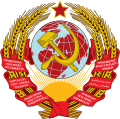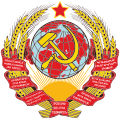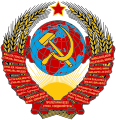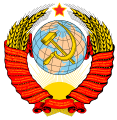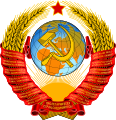State Emblem of the Soviet Union facts for kids
Quick facts for kids State Emblem of the Union of Soviet Socialist Republics |
|
|---|---|
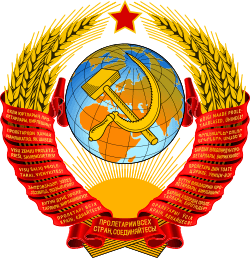 |
|
| Armiger | |
| Adopted | 6 July 1923 |
| Motto | Workers of the world, unite! |
| Earlier version(s) | 1923, 1929, 1936, 1946 |
The State Emblem of the Soviet Union was the official symbol of the Soviet Union (USSR). It was adopted in 1923 and used until the country broke apart in 1991.
Even though it's called an "emblem," it's often referred to as a "coat of arms" in Russian. This is because it doesn't follow the old rules of heraldry, which is the art of designing coats of arms.
This emblem was the first of its kind to use a style called socialist heraldry. You can see similar designs in the symbols of other socialist countries, like East Germany and China.
Contents
History of the Emblem
How the Emblem Was Created
In late 1922, a group started working on new Soviet symbols. They designed the first Soviet stamps and money. On January 10, 1923, a special committee was formed to create the state emblem and flag.
This committee decided what the main parts of the emblem should be. These included the sun, the Hammer and Sickle (a symbol of workers and farmers), and the famous motto: "Proletarians of all countries, unite!"
In February 1923, the task of designing the emblem went to Goznak, a company that made state symbols. Many artists created their own ideas. One artist, K.I. Dunin-Borkovsky, even tried to make it look like a traditional coat of arms with a shield.
Ideas That Were Chosen
V. N. Adrianov, a leader at Goznak, came up with a design that was very close to the final emblem. He suggested including a globe to show that the Soviet Union was open to all nations.
Later, on June 28, 1923, he changed his design. He replaced the letters "СССР" (USSR) with a red star at the top of the emblem.
Final Approval
The chosen design was then redrawn by another artist named Ivan Dubasov. In his first drawing, the motto was on a red ribbon at the bottom. But then, they decided to put the motto in six different languages on ribbons wrapped around the emblem.
First Design (1923–1936)
The first official design of the state emblem was approved on July 6, 1923. It was officially described in the 1924 Soviet Constitution.
This first emblem showed a sickle and hammer over a globe, with sun rays behind it. It was framed by wheat ears. The motto "Workers of the world, unite!" was written in six languages: Russian, Ukrainian, Belarusian, Georgian, Armenian, and Azerbaijani. The Russian version was in the middle. At the very top was a five-pointed star.
Vladimir Adrianov created the design, and Ivan Dubasov finished it. In 1931, the Tajik language was added to the motto ribbons. This happened after the Tajik Soviet Socialist Republic (SSR) was formed in 1929.
Second Design (1936–1946)
The Soviet Union grew to have eleven republics by 1936. Because of this, the emblem was updated. The biggest change was that the motto now appeared on eleven ribbons, one for each language of the republics. New languages added included Turkmen, Uzbek, Kazakh, Kyrgyz, and Tajik.
Third Design (1946–1956)
After World War II, the number of republics in the USSR increased to 16. This happened because the Soviet Union added new areas like the Baltic states and parts of Ukraine and Finland.
On June 26, 1946, the emblem was changed to show all 16 republics. The motto was now written on 16 ribbons in 16 different languages. Some language spellings were updated because they changed from the Latin alphabet to the Cyrillic alphabet. New languages like Estonian, Latvian, Lithuanian, Moldavian, and Finnish were also added.
Fourth and Final Design (1956–1991)
In 1956, one of the republics, the Karelo-Finnish SSR, became a smaller region within the Russian SFSR. So, the emblem was updated again. On September 12, 1956, the ribbon with the Finnish version of the motto was removed.
A small change was made to the Belarusian inscription on April 1, 1958.
The motto on the ribbons, which means "Proletarians of the world, unite!" in English, was written in many languages:
| Left | Right |
|---|---|
| Turkmen: Әхли юртларың пролетарлары, бирлешиң! (Turkmen) | Estonian: Kõigi maade proletaarlased, ühinege! (Estonian) |
| Tajik: Пролетарҳои ҳамаи мамлакатҳо, як шавед! (Tajik) | Armenian: Պրոլետարներ բոլոր երկրների, միացե՜ք (Armenian) |
| Latvian: Visu zemju proletārieši, savienojieties! (Latvian) | Kyrgyz: Бардык өлкөлөрдүн пролетарлары, бириккиле! (Kyrgyz) |
| Lithuanian: Visų šalių proletarai, vienykitės! (Lithuanian) | Moldovan Cyrillic: Пролетарь дин тоатe цэриле, уници-вэ! (Moldavian) |
| Georgian: პროლეტარებო ყველა ქვეყნისა, შეერთდით! (Georgian) | Azerbaijani: Бүтүн өлкәләрин пролетарлары, бирләшин! (Azerbaijani) |
| Uzbek: Бутун дунё пролетарлари, бирлашингиз! (Uzbek) | Kazakh: Барлық елдердің пролетарлары, бірігіңдер! (Kazakh) |
| Ukrainian: Пролетарі всіх країн, єднайтеся! (Ukrainian) | Belarusian: Пралетарыі ўсіх краін, яднайцеся! (Belarusian) |
| Russian: Пролетарии всех стран, соединяйтесь! (Russian) | |
Even after the Soviet Union ended in 1991, the emblem still appeared on Soviet money until 1994. Many former Soviet countries then started using their own money. The official use of the Soviet emblem mostly stopped in 2002 when Russia and other former republics stopped issuing Soviet passports. However, you can still see it in many public places in Russia today.
What the Emblem Shows
The state emblem features the well-known Soviet symbols: the Hammer and Sickle and the Red Star. These are placed over a globe. Two wreaths of wheat surround the globe. Wrapped around the wheat are ribbons with the motto "Workers of the world, unite!" written in the official languages of the Soviet Republics.
Each Soviet Republic and Autonomous Soviet Republic also had its own emblem. These were mostly designed to look similar to the main Soviet Union emblem.
Gallery
See also
 In Spanish: Escudo de la Unión Soviética para niños
In Spanish: Escudo de la Unión Soviética para niños
- Emblems of the Soviet Republics
- State Quality Mark of the USSR
- Flag of the Soviet Union
- Emblem of the Russian Soviet Federative Socialist Republic
- Coat of arms of Russia
- National Emblem of the People's Republic of China
- National emblem of East Germany


